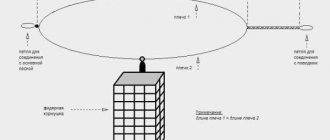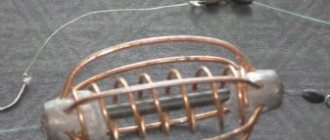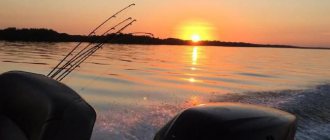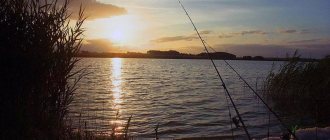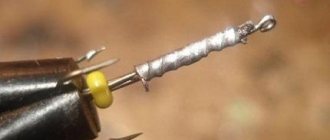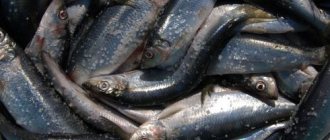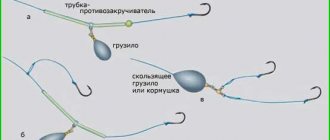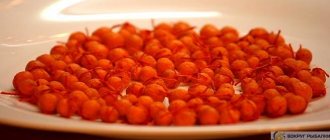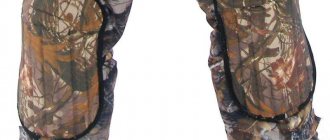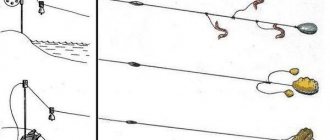Design features
The helicopter does not require the use of a winter rod and reel.
In this case, you can get by with just one reel, on which a fishing line with a sinker, a leash and hooks is wound. When assembled, it all looks intricate, but in fact there is nothing complicated in such a design. A piece of monofilament fishing line with a diameter of up to 0.25 mm (the length is selected depending on the depth at the fishing site) is fixed on the reel at one end, and a swivel is first put on the opposite end, and then a sinker in the shape of a bullet or pyramid is tied to it. The weight of the load depends on the strength of the water flow. As a rule, 40 g is enough. A meter-long leader with approximately half the diameter of the main fishing line is installed on the swivel. 3 or 4 hooks are tied on it at a distance of 20-25 cm from one another. The device ends with a so-called pinwheel, similar to a block of metal staples for a stapler, only larger. The end of the leash is fixed in a hole made in the center of one of its sides. To prevent the fishing line from rubbing against the edge of the metal, you can insert another swivel into the hole and clamp it tightly.
Instructions for creating a helicopter rig
The first step is to decide on the length of the fishing line; it depends on the depth of the reservoir.
You won't need more than 20 meters. Only fishing line with a thickness of less than 0.25 mm is suitable so as not to get tangled. At the end of the main part, a three-meter insert is made from fishing line with a thickness of 0.18-0.2 mm . A short leash with a hook is tied every meter. The distance between the hooks can be made smaller, but larger is undesirable. Installing additional hooks is non-functional, causing difficulties with transportation and use.
At the end of the structure, a heavy (up to 50 g) olive- or pear-shaped sinker , capable of withstanding the force of the current, is attached through a locking ring.
The spinner is an element due to which this fishing tackle is called a helicopter. It is made of thick tin or steel . It is a U-shaped sheet of metal with a hole in the center. You can make this by bending a metal plate in two places. The recommended size for a turntable in a flat state is 6*6 cm, sides - 2 cm. The angle at which the plate is bent should be about 90 degrees, but you should not be tied to the number. The main thing in a propeller is its ability not to be deformed by the flow.
A carabiner is threaded through the hole in the turntable for fastening.
The process of assembling a helicopter with your own hands step by step:
- Wind the line onto the reel.
- Attach the sinker to the reel.
- Use a swivel to secure the hooks and pinwheel.
For those who are used to fishing with a fishing rod, attaching a reel to it will not be a problem. If there is no cambric, a thin bendable branch is attached to the structure. Its bending will indicate the presence of a catch.
Fishing by helicopter in winter is only possible in places with current . You can use it in standing water, but it is not effective. You will have to equip the fishing line with additional weights at different points so that the fishing line is stretched to its full length.
Selection of materials
The helicopter is made from scrap materials. All elements of the tackle can be obtained from a fishing store. For this you will need:
- Reel. Purchased plastic or homemade, carved from wood.
- The main monofilament line is 0.25–0.35 mm thick, 15–30 meters long.
- A lead sinker of a flattened or diamond shape. Its weight is selected according to the strength of the current and the depth at the fishing site.
- The main leash is a monofilament line with a thickness of 0.18–0.25 mm. The minimum length is 1 meter, the maximum is 3 meters.
- The leashes are made from monofilament with diameters of 0.14–0.18 mm. Their length is 5–30 cm.
- The size and shape of the hook is selected according to the bait and the potential size of the prey.
Additionally, for the helicopter you will need swivels, double and triple, for mounting equipment, multi-colored cambrics for decorating hooks and sheet metal for making a turntable:
Tip: You can use the bottom of a half-liter tin can as a pinwheel.
- A rectangular blank is cut out of a piece of sheet metal 0.5–0.8 mm thick. Its size depends on the strength of the current. The average pinwheel size is 7 by 10 cm.
- Using pliers or a vice, bend the long sides of the workpiece to form a U-shaped profile.
- A hole is made in the middle of the workpiece for attaching the pinwheel to the fishing line of the fastener with a swivel.
The spinner is the main component of the gear, which is why it was called a helicopter.
The sequence of installation of helicopter gear for winter fishing is as follows:
Fishing place
Website about fishing
- home
- Fishing
- Winter fishing
- Helicopter tackle for winter fishing
- Winter fishing
- Tackle
I decided to share with everyone my experience of making and fishing with one of the most popular winter river gear in the Kaluga region. Here it is called a “helicopter”. For the first time I had a chance to observe this tackle in action about 15 years ago, and I was immediately surprised by its effectiveness even during a period of almost complete absence of bite. What was most captivating about it was the clever combination of design features with the use of the power of the river flow. You can fish with this gear all winter, but it especially often helps out during the “deaf winter.” To make a “helicopter” you do not need any special materials or devices. Everything you need is easily accessible and always at hand for any angler.
What kind of gear is this and its features
It is enough to see a fishing helicopter once and you will already understand how it works. The main line is lowered to the bottom using a sinker. A leash about a meter long is tied in front of the sinker, to which several hooks or jigs are attached at a distance of about 25-30 cm from each other. A small, preferably tin structure, reminiscent of a block of paper clips for a stapler, is attached to the very end of the leash using a swivel.
Step-by-step instructions for installing fishing equipment
Materials and tools
We have already talked about the composition of the gear. Let's take a closer look at the turntable itself. It should not be too large so as not to scare away the fish . The tin is selected from a tin or beer can. It should have good buoyancy and not drag along the bottom. But if you take a very thin sheet metal, it will be deformed by the flow, and rotation will not occur.
Another peculiarity of the tackle is that, rising from the bottom, the spinner will tighten the main leash so that the hooks will be at different heights. In this way, you can calculate those layers of water where fish are more active. Which hook bites more often, such depth and catchability. Having calculated the places where fish gather. You can switch to active fishing using a regular winter fishing rod.
It turns out that to make a turntable we will need strong scissors for cutting tin, pliers for bending it, fishing line, hooks, sinkers and swivels. Another twig for a nod, if you don’t have a factory one.
Manufacturing process
It is simple and easy to do by hand:
- bend a pinwheel of the required size into a rail shape; you can make several removable ones of different weights and sizes at once;
- make a hole strictly in the middle; through which we pass the end of the main leash;
- we secure the leash with a swivel so that the line does not fray during rotation;
- we attach hooks on short leashes to the main leash, there is no need to make a lot of them, 3-5 are enough so that the leashes do not get tangled;
- We attach a sinker and a main leash with hooks to the main line;
- don't forget the whip.
Fishing by helicopter in winter
5 minutes Author: Dmitry Tishchenko 0
- Advantages of helicopter fishing
- How to make tackle?
- How to catch?
- Video on the topic
Many fishermen avoid fishing in medium and fast currents in winter, since fishing in such conditions is not easy. This requires special gear and certain skills that will allow you not only to effectively hold the equipment at the bottom, but also to entice a variety of fish to bite.
One of such equipment is a helicopter. This is an extremely productive bottom tackle for winter fishing from ice in riverbed areas, which allows you to qualitatively fish any promising point. Used for fishing bream, roach, silver bream, ruffe and other peaceful representatives of the ichthyofauna.
The presented equipment is known to fishermen not only under the name “helicopter”. In some regions it is called “ends,” and in some places you can find the expression “fishing with a can” or “fishing with a bottle.” The essence does not change from this. A helicopter is a productive tackle for bottom fishing in currents. It can often be seen on the Volga, Oka, Don and other deep rivers.
The presented equipment is known to fishermen not only under the name “helicopter”. In some regions it is called “ends,” and in some places you can find the expression “fishing with a can” or “fishing with a bottle.” The essence does not change from this. A helicopter is a productive tackle for bottom fishing in currents. It can often be seen on the Volga, Oka, Don and other deep rivers.
How to feed bream in winter?
How to make feeder tackle
With the onset of cold weather, bream goes to a depth of 5 meters due to lack of oxygen. He loves to be in holes, dumps or on the edge. You can also look for it near springs gushing from the bottom, where streams flow into rivers. Adverse weather conditions force bream to sink lower and lower to the bottom of deep holes, where the amount of oxygen remains high.
The search for bream at this time can be carried out as follows:
- The fisherman determines the best place for the catch, studies the condition of the bottom and depth, changes places and drills many holes.
- Finds a permanent place. He drills holes not far from each other (10-20 m), starts feeding, and determines where the catch is best.
- In a familiar body of water there is already a feeding place where several holes have been drilled, located nearby. Then you can put up a tent using ordinary candles for heating.
Avid fishermen know that bream is especially active at night (from 10 pm to 1 am). This method is just right for night fishing.
In winter, bream looks for food of animal origin. Its calorie content replenishes the energy spent by fish in difficult conditions. This is mainly the dracena shell, as well as crustaceans, bloodworms and other larvae that are carried away by the current and cling to the rocky bottom.
If the bite does not happen, you need to start drilling holes in other places: along the slopes parallel to the shore, as well as at the lower edge of the hole.
A systematic search will sooner or later lead to success. The main thing is to be careful and not fall into the water due to fragile ice on the gullies.
Now only mine bites!
I caught this pike using a bite activator. No more fishing without a catch and no more looking for excuses for your bad luck! It's time to change everything!!! The best bite activator of 2021! Made in Italy…
MORE DETAILS
We suggest you read: How to fish with a float rod in the current?
In this case, the following rules must be observed:
- When making bait, do not use aromatic components, since in winter bream is very sensitive to odors.
- Add bloodworms or maggots to the food. This will make it more attractive to fish.
- Mix the bait with breadcrumbs, which, when sprayed, will form a feeding path.
- To prevent the feeder from floating, the food is mixed with sand or pebbles taken from the river bank.
- Moisten the food with water from the hole so that the bream does not smell any foreign odors.
The basis of complementary feeding should be bloodworms, add semolina, milk powder, and sunflower cake to it. It is good to use frozen bloodworms. A mixture of bloodworms, sand, and water is frozen in plastic forms; during fishing, these cubes are lowered to the bottom, they thaw slowly, and the fish stays at the food longer. In this form, complementary foods are well stored.
The feeder is placed upstream so that the food is carried to the tackle. Complementary food must be well prepared, because in cold water it quickly deteriorates and repels fish with its smell. As a rule, half an hour is enough for the fish to feel the bait.
Any angler can fish with a helicopter in winter. The tackle is simple and passive.
The main task is to locate fish sites. If on a familiar river, where the topography and behavioral characteristics of the local underwater inhabitants are known, it is easy to find a catching point, then on a new body of water you will have to look for a promising area.
An echo sounder or flasher is suitable for this, which will allow you to study the condition of the bottom. You can use a depth gauge or “ring” the area with a fishing rod with a reel and an eared sinker tied to the end of the fishing line. Then holes are drilled at intervals of 20–25 meters in a checkerboard pattern. Helicopters are installed in them. It is irrational to use more than 5-6 gear.
When fishing with a helicopter, the angler does not need to play with gear. It is enough to load the hooks with bait and lower them to the bottom. The current is to pick up the equipment and do everything yourself. All that remains is to detect the bite in time and bring the fish into the hole.
Helicopter tackle for ice fishing
The helicopter tackle is original and very popular among the fishing community, and especially among Kaluga winter fishermen. As part of this review, Alexander Zaiko decided to share his secrets of making this original winter fishing gear for fishing on currents:
“The pages of your website regularly publish materials containing descriptions and techniques of fishing with various fishing tackles and devices. I decided to share with the entire “fishing fraternity” my experience in making and fishing with one of the most popular winter river gear in the Kaluga region.
Here it is called a “helicopter”. For the first time I had a chance to observe this tackle in action about 15 years ago, and I was immediately surprised by its effectiveness even during a period of almost complete absence of bite. What was most captivating about it was the clever combination of design features with the use of the power of the river flow.
You can fish with this gear all winter, but it especially often helps out during the “deaf winter.” To make a “helicopter” you do not need any special materials or devices. Everything you need is easily accessible and always at hand for any angler.
The design of the gear consists of:
- tin pinwheel;
- long leash;
- short leashes with hooks;
- retaining ring;
- sliding sinker;
- main line;
- fixing cambric;
- reel for attaching all the gear;
- bite alarm whip.
The diameter of the pinwheel can vary within 5 cm. The pinwheel is attached to a long leash using a small swivel. To make a long leash, it is better to use a fishing line with a diameter of 0.22-0.25 mm and a length of about 1.5 m. Three or four short leashes are attached to the long leash at the same distance from each other using a “loop-to-loop” method or using swivels ( 12-15 cm long from fishing line 0.15-0.2 mm) with hooks.
Feeder
You can use any feeder, but in this version of feeder fishing, feeders in the form of containers are most often used, where maggot larvae are placed.
IT IS IMPORTANT TO KNOW! Fishermen caught 25 kg of fish using the Fish XXL ! Read more.
1. A piece of fishing line 20 cm long and folded in half.
2. In this form, you need to measure another 15 cm and make a knot (the “figure eight” knot in this case is more suitable than others).
3. You need to measure another 1 cm from the knot and tie another figure eight.
4. Using the cape method, insert the feeder into a large loop (or loop into a loop).
5. The “Helicopter and 2 knots” feeder rig is almost ready, its total length is a maximum of 0.5 meters (this will make it more convenient to throw the gear).
A simple “Helicopter” feeder rig with two nodes is a classic
Installation of the “Helicopter” is quite simple:
- We fold the end of the main fishing line in half - 10-15 centimeters and knit it with a Figure Eight knot - we get a loop that serves to attach the feeder.
- A little higher, 2-3 centimeters, we knit another Figure Eight knot. This distance between the two knots is used to attach the leash with the hook.
Tips for fisherman: Catching roach with a reelless reel in winter video - What is the difference, pros and cons
That’s it, our simple bottom-feeder rig “Helicopter” with two units is ready!
Attention! The length of the leash should be 10 centimeters greater than the distance from the bottom node to the end of the feeder. That is, if you fold the tackle, the hook is located 10 cm below the feeder.
To attach the feeder and leash, a “Stroke” knot is used.
Now let's look at the composition of this gear in detail. The following components are needed:
Helicopter tackle for ice fishing
The helicopter tackle is original and very popular among the fishing community, and especially among Kaluga winter fishermen. As part of this review, Alexander Zaiko decided to share his secrets of making this original winter fishing gear for fishing on currents:
“The pages of your website regularly publish materials containing descriptions and techniques of fishing with various fishing tackles and devices. I decided to share with the entire “fishing fraternity” my experience in making and fishing with one of the most popular winter river gear in the Kaluga region.
Here it is called a “helicopter”. For the first time I had a chance to observe this tackle in action about 15 years ago, and I was immediately surprised by its effectiveness even during a period of almost complete absence of bite. What was most captivating about it was the clever combination of design features with the use of the power of the river flow.
You can fish with this gear all winter, but it especially often helps out during the “deaf winter.” To make a “helicopter” you do not need any special materials or devices. Everything you need is easily accessible and always at hand for any angler.
The design of the gear consists of:
- tin pinwheel;
- long leash;
- short leashes with hooks;
- retaining ring;
- sliding sinker;
- main line;
- fixing cambric;
- reel for attaching all the gear;
- bite alarm whip.
Since the tackle is self-hooking, the hooks must be very sharp and thin. Red OWNER hooks No. 12-14 are best suited for this purpose. Above the hooks you can place additional white mother-of-pearl beads. A long leash with a spinner and short leashes is attached to the main line using a locking ring. On the main line with a diameter of 0.35-0.45 mm there is a sliding sinker weighing 60-80 g.
"Helicopter" options
History is silent about who invented editing. The equipment is quite young, but has already proven itself from the best side and earned the respect of fishermen.
Currently, connoisseurs of bottom fishing use the classic knitting pattern with two knots and variations on it, where instead of tied knots, silicone stoppers, lead pellets, beads are used, complemented by carabiners and swivels. As an example, Baryshev’s helicopter.
In the latter cases, mounting may be faster and more convenient, but some additional elements bothered me a little when fishing.
The equipment visually looks more massive, and there have been many cases when the leash caught on the stopper, the carbine. And this periodically causes dissatisfaction.
Which installation scheme to use is a personal choice, but I prefer the original.
Essentially, the helicopter effect is that a leash clamped between two knots spins freely around the main line with a feeder or a smooth, streamlined lead weight and does not get tangled.
How to increase your fish catch?
Do-it-yourself tackle for carp, its installation and fishing with donk
Over 7 years of active fishing, I have found dozens of ways to improve the bite. Here are the most effective ones:
- Bite activator. This pheromone additive attracts fish most strongly in cold and warm water. Discussion of the bite activator “Hungry Fish”.
- Increased gear sensitivity. Read the appropriate manuals for your specific type of gear.
- Pheromone-based lures.
- Bream fishing depending on the month of fishing ↓
- September ↓
- October ↓
- November ↓
- Bait for autumn bream ↓
- Fishing technique in autumn ↓
Feeder rod of at least 3.9 meters for long casts
The reel is inertia-free (bayrunner is optional), the only condition is a well-tuned and functioning friction brake (rear or front does not matter)
Monofilament line diameter 0.25. We recommend Salmo Feeder Specialist - this durable and practically non-stretching fishing line will allow you to effectively track all bites, make long casts due to its small thickness and not rub against stones or shells.
Hooks with a long shank to match the size of the fish’s mouth (usually No. 7-9. Should fit easily into the mouth opening.
Feeder rigs for fishing on currents:
- helicopter and two knots;
- paternoster;
September
In September there is a very active bream bite. Fishing on calm, clear days, especially early in the morning or late in the evening, before sunset, gives good results. In cloudy and windy weather, you can try your luck by finding a relatively calm place.
When fishing for bream, it is very useful to use fine bait, which makes it possible to keep the bream in the place necessary for the fisherman for a long time, without allowing the fish to get enough.
In September, the following perform well as bait:
- worm;
- maggot;
- bread;
- dough (one type of dough is hominy);
- cereals;
Methods for planting maggots and bloodworms are described here.
The use of bait is very justified. Feed the same place every day. But to save time, you can simply fish in the same place for several days. This will definitely give a positive result.
October
In October there is a decrease in bream biting activity. This is due to the accumulation of fat before cold weather, the bream is full and feeding lasts no more than 4 hours a day.
At this time, the fish gather in schools and stay at a considerable depth, constantly moving around the reservoir.
In October, bream, as a rule, takes the bait that lies on the bottom, so the “helicopter and two knots” rig will be less appropriate. “Paternoster” or other bottom mounts will perform better.
Bait (animal components only):
- worm;
- bloodworm;
- less often maggot;
The bait must necessarily contain an animal component, or better yet be based on bloodworm extract. Bream in cold water prefer food with a predominantly protein component.
November
In November, the bream bite is unstable and you have to look for it in very deep areas. You most likely won’t find it where you caught it in the summer. The pits near which it is located will be used by it in winter for wintering. The temperature in them does not drop to critically cold levels, and this allows you to endure the hardships of cold winters more calmly.
We recommend using long feeders up to 4.2 meters for long casts and fishing in pools up to 15 meters deep. In order to find a place, you can use a marker float or a portable coastal echo sounder.
Bait - any bloodworms, maggots, but they need to be planted not in bunches, as in the summer, but in 1-2 larvae.
Groundbait - based on animal components for cold water. The easiest way is to buy it in a store; at home it is very difficult to prepare minced bloodworm. Give preference to the following brands: Dunaev, Trapper, Sensas.
Winter gear "helicopter"
Winter helicopter gear is original and very popular among the fishing community, and especially among Kaluga fishermen. As part of this review, Alexander Zaiko decided to share his secrets of making this original winter fishing gear for fishing on currents:
“The pages of your website regularly publish materials containing descriptions and techniques of fishing with various fishing tackles and devices. I decided to share with the entire “fishing fraternity” my experience in making and fishing with one of the most popular winter river gear in the Kaluga region.
Here it is called a “helicopter”. For the first time I had a chance to observe this tackle in action about 15 years ago, and I was immediately surprised by its effectiveness even during a period of almost complete absence of bite. What was most captivating about it was the clever combination of design features with the use of the power of the river flow.
You can fish with this tackle all winter, but it especially often helps out during the “deaf winter.” To make a “helicopter” you do not need any special materials or devices. Everything you need is easily accessible and always at hand for any angler.
The design of the gear consists of:
- tin pinwheel;
- long leash;
- short leashes with hooks;
- retaining ring;
- sliding sinker;
- main line;
- fixing cambric;
- reel for attaching all the gear;
- bite alarm whip.
The design of the gear consists of:
What bait should I use?
To make the fisherman happy with his catch in winter, the following fishing rods are used:
- fishing rod with a nod;
- fishing rod with float;
- tackle for the current.
Thin ones are not carried away by the current and are not so noticeable. Hooks - NoNo5-8.
In winter, bream is shy and cautious. Therefore, the equipment of the gear is aimed at making it light and elegant. The hand will not get tired from the constant movement of the fishing rod. Fishermen consider a helicopter to be an excellent tool for fishing in currents.
The leash, equipped with a tin spinner, moves freely in the water, attracting fish. When swallowing the bait, the bream does not feel the tension of the line and does not spit out the hook.
After waiting the right time, you can lower the bait. Bloodworms are used for this.
Bream likes to have a lot of bait, so several bloodworms and another piece of green cambric are put on the hook. Bream can also be attracted by a bait of small dung beetles or underleaf worms.
They are kept in a box with soil in a cold room. You can use maggots. All baits are strung on a hook in several pieces.
Helicopter gear for winter fishing: how to make it yourself
16.06.2019 0
Every year, due to severe fishing pressure and unpunished poaching, there is less and less fish in our waters, so amateur fishermen have to come up with new ways of fishing. In winter, fishing is also complicated by unfavorable weather conditions, but fishing from ice still has its advantages.
Continuous ice cover allows you to fish every corner of the reservoir and check all promising points that are inaccessible in the summer. True, sometimes you have to search for fish for hours, so many people use devices that can be used to fish a large area in a short time. This is exactly what helicopter gear for winter fishing belongs to. With it you can successfully catch not only peaceful river inhabitants active in cold weather, such as bream, white bream, silver bream, roach, bluegill, white-eye, but also some predators (for example, perch).
This is bottom tackle designed for fishing from ice in current conditions. In essence, this is the same garland, only it catches not in a vertical plane, but in a horizontal one.
Classic helicopter and two knots
Another advantage of the helicopter and two feeder units is ease of installation. The base on the fishing line is knitted in a couple of minutes. And the further use of the helicopter depends on the leashes with which it is equipped.
Helicopter and two knots diagram:
- You can knit both on braid and monofilament. It doesn’t make sense to bother with it and knit it separately, like an asymmetrical loop. We just do it on the main line or shock leader. We fold the fishing line in half and tie a 10-15 cm long loop at the end with a figure eight knot, as in the Gardner paternoster. Here we will use a noose to hook the feeder into the eye of the swivel.
Depending on the equipment, the helicopter and two units for the feeder with leashes and further fishing takes place. Options are selected depending on the purpose of fishing:
- Short powerful leashes in still water - for catching carp and large crucian carp, when you need the hook with the nozzle to lie on the bottom not far from the feeder.
- Standard leashes, thin, 0.7-1.5 meters long - for classic feeder fishing for white fish in the current, like with a paternoster or a Gardner loop. The stream places the bait in the feed stream below the feeder trough at an appropriate distance. To catch large fish with a feeder in this way, you need to use a monofilament fishing line - the cord does not stretch, the equipment does not absorb shocks, and a thin leash is easy to break when fishing.
- Fishing with a feeder using a floating bait. During the current, a long leash can fall to the bottom within a minute or two. This may be enough for fish pecking in the thicker water above the bottom to find the bait. This method of fishing is only possible with this particular equipment, so a helicopter significantly expands the feeder’s capabilities. Bottom tackle does not always mean fishing from the bottom. Let's look at this issue in more detail - sometimes this fishing method works, especially in the spring, when the bait lying on the bottom does not bring a bite at all.
Feeder fishing with falling bait
Of all the rigs, it is the helicopter feeder rig that is most suitable for such fishing. In order for the bait to sink to the bottom as slowly as possible in the bottom rig, you need to maintain the following points:
- The attachment point of the leash to the base is above the feeder. We remove the inline, symmetrical loop. What remains is the asymmetrical, paternoster, inline with bend and helicopter.
- A thin leash should move away from the base immediately, without heavy weighting components - fluoro bends, twists, as all this speeds up the fall of the bait to the bottom. Actually, on all remaining feeder installations, except for the helicopter, there is such a bend or twist. Therefore, there is only one option left - a helicopter.
Catching bream on a helicopter
The helicopter tackle is distinguished by its extraordinary simplicity and originality, it is very common for catching bream at great depths and on currents, and bream are caught with such tackle both in winter from the ice and in the rest of the year, ensuring a high degree of effectiveness of such fishing.
As mentioned above, fishermen catch bream with this gear almost all year round, but this gear is especially good during the dead of winter. To prepare this tackle, no special knowledge or special materials are required; all materials are quite accessible and are available to almost every fisherman.
